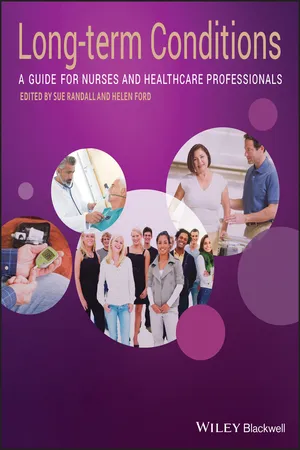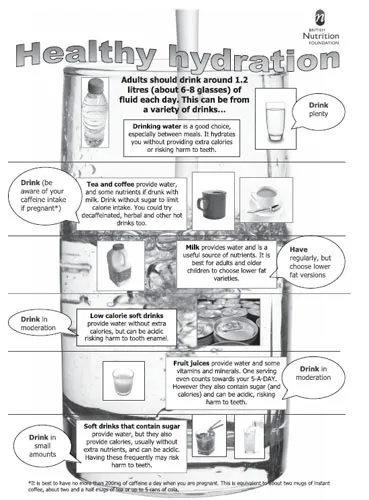
eBook - ePub
Long-Term Conditions
A Guide for Nurses and Healthcare Professionals
This is a test
- English
- ePUB (mobile friendly)
- Available on iOS & Android
eBook - ePub
Book details
Book preview
Table of contents
Citations
About This Book
Long Term Conditions is a comprehensive textbook for all nursing and healthcare students and practitioners that explores the key issues surrounding caring for patients with chronic diseases or long-term conditions.
Divided into three sections, this book explores living with a long-term condition, empowerment, and care management. Rather than being disease-focused, it looks at key issues and concepts which unify many different long-term conditions, including psychological and social issues that make up a considerable part of living with a long-term condition. Within each of the chapters, issues of policy, culture and ethics are intertwined, and case studies are used throughout, linking the concepts to specific diseases.
Key features:
- A comprehensive textbook on the principles and practice of caring for people with long-term conditions
- User-friendly in style with learning outcomes, further reading, useful websites, and case studies throughout linking to specific conditions
- Moves away from a disease-focused medical model, and takes a needs-led approach
- Uniquely explores the overarching issues of living with one or more long-term conditions
- Focuses on the importance of multi-disciplinary team work and collaborative teamwork in the management of long-term conditions
Frequently asked questions
At the moment all of our mobile-responsive ePub books are available to download via the app. Most of our PDFs are also available to download and we're working on making the final remaining ones downloadable now. Learn more here.
Both plans give you full access to the library and all of Perlego’s features. The only differences are the price and subscription period: With the annual plan you’ll save around 30% compared to 12 months on the monthly plan.
We are an online textbook subscription service, where you can get access to an entire online library for less than the price of a single book per month. With over 1 million books across 1000+ topics, we’ve got you covered! Learn more here.
Look out for the read-aloud symbol on your next book to see if you can listen to it. The read-aloud tool reads text aloud for you, highlighting the text as it is being read. You can pause it, speed it up and slow it down. Learn more here.
Yes, you can access Long-Term Conditions by Sue Randall, Helen Ford in PDF and/or ePUB format, as well as other popular books in Medizin & Krankenpflege. We have over one million books available in our catalogue for you to explore.
Information
Section 1
Living with a Long-term Condition
Chapter 1
Nutrition
Learning objectives
After reading this chapter, the reader will have:
- Gained an understanding of how nutrition is a factor both in the cause of LTCs and as a treatment of LTCs
- Developed their understanding of the components of a healthy diet, and be able to demystify dietary advice for patients/clients
- A greater knowledge of obesity, its aetiology, link to LTCs, and current treatment recommendations
- Enhanced their understanding of undernutrition in LTCs, and how this can be identified and treated effectively
Introduction
This chapter explores the importance of good nutrition in both the prevention and management of long-term conditions (LTCs). The impact of poor diet and nutrition on individuals will be discussed, including obesity and, at the other extreme, undernutrition. In particular, the reasons why people with LTCs are at risk of poor nutrition will be examined, including both the effects of hospitalisation and exacerbations of disease. By the end of the chapter, it is hoped that the reader will have a solid foundation of knowledge about nutrition, and that they will be able to use this knowledge in improved assessment and care of their patients.
Nutrition in context
The Department of Health (DH) (2008a) state that 15.4 million people (almost one in three of those living in England) have an LTC. This statistic includes people across the age continuum, yet of those over 60, the proportion with an LTC increases to three out of five people. As has been identified elsewhere in this book, LTCs do not necessarily occur singly as people may have more than one LTC, and again this incidence rises as age increases. For example, to look at some common conditions:
- In England, 6.7 million people have clinically identified hypertension.
- Diabetes (Types 1 and 2) affects 174, 000 or 6% of the Welsh population.
- 864, 000 people will experience a stroke at some point in their lives across England and Northern Ireland.
- Coronary heart disease affects almost 2 million people in England, from a population of approximately 61 million. This equates to 3.3% of the population, whereas in Scotland this percentage rises to 4.2%.
Sources: Department of Health 2008b, The Scottish Executive 2003, Welsh Assembly Government 2008, Northern Ireland Executive 2009.
For conditions such as these, diet has been identified as one of the main factors influencing whether someone will develop them or not. Demographic data from the DH suggest that there is wide variation in prevalence of these diseases across the United Kingdom and access to the right kinds of foods to maintain a healthy diet is undoubtedly important. For example, the White Paper ‘Towards a Healthier Scotland’ (The Scottish Office 1999) stated that Scotland’s diet is a major cause of poor health, and that the Scottish diet is traditionally high in fat, salt and sugar, and low in fruit and vegetables. In addition, households that include someone with an LTC are more likely to be low earners, and those on low wages are less likely to be able to afford or have access to healthy food. The World Health Organisation (WHO 2002: 30) in their consultation document ‘Diet, Nutrition and the Prevention of Chronic Disease’ argue that in fact, events during the life-course of an individual are as important when considering good nutrition as focusing on snapshots in time, and that
such factors are also being recognized as happening further and further ‘upstream’ in the chain of events predisposing humans to chronic disease.
However, it must be recognised that some LTCs are not precipitated by diet and other lifestyle factors. For individuals with conditions such as chronic obstructive pulmonary disease (COPD), rheumatoid arthritis (RA) or osteoarthritis, neurological conditions such as epilepsy, motor-neurone disease or multiple sclerosis, or mental health problems such as depression or dementia, poor diet may not have been a factor in the cause of the disease. However, as the reader will see, research into the role of good nutrition and health is showing that interventions to ensure that malnutrition is prevented, detected and managed can positively affect the outcome of a disease, modify symptoms, and reduce morbidity and mortality. This idea, of promoting nutrition to the forefront of a care programme, can be known as ‘nutrition as treatment’ and it recognises the power of carefully planned nutrition interventions to maintain positive health. However, nutrition does not happen in a vacuum, and the social, cultural, political and economic environment in which a person lives will all affect their eating habits.
How nutrition fits into the management of LTCs
As the number of people with one or more LTCs continues to grow over the next 20 years, the DH (2005) argue that health and social care services will need to focus on improving health outcomes through better detection and prevention of health problems. Promoting the benefits of a healthy lifestyle, including diet, can improve a person’s quality of life and allow them to lead as full a life as they choose rather than becoming isolated and defined solely by their disease. An example of this is hypertension. The Health Survey for England (Office for National Statistics 2005) found that among people with no LTC, approximately 9% had a blood pressure (BP) above 150/ 90. However, this figure rose to 50% for people with one or more LTCs. The DASH (Dietary Approaches to Hypertension) study (Harsha et al. 1999) is a famous study that showed after eight weeks of a diet rich in fruit and vegetables and low fat dairy products, an 11.4 mm Hg drop in systolic BP and a 5.5 mm Hg drop in diastolic BP was observed in hypertensive subjects, compared with those eating a standard American diet. Gaining control of blood pressure alone would reduce the risks of further health problems and may also mean fewer tablets to take in the morning! For the person with an LTC, well-being would be improved as their confidence increased in their ability to manage the disease, rather than the disease managing them, and this could in turn lead to further positive changes in lifestyle.
Promoting health
The DH has identified four levels of care for LTCs (DH 2005). The first level is that of promoting health, both in the population as a whole to prevent LTCs from developing in the first place, and for those already with an LTC. For those working in health and social care, supporting people to make healthy choices is as important as other more clinical roles. Good knowledge of what constitutes a healthy diet is important here, as is being able to empower people to manage obesity and stabilise weight. Hydration must be included within this; for example, adequate hydration reduces risk of falls among the elderly (American Geriatrics Society, British Geriatrics Society and American Academy of Orthopaedic Surgeons Panel on Falls Prevention 2001). An example of a visually appealing tool to promote healthy hydration has been produced by the British Nutrition Foundation (2010b) and can be seen in Figure 1.1.
Supported self-care
The second level is supported self-care and aims to empower people with LTCs to manage their condition effectively by improving skills and knowledge. The Expert Patients Programme (EPP), for example, is one initiative where individuals are trained by others with an LTC in how to best help themselves to cope with their condition. How to improve diet and maintain optimum health is one of the possible training sessions available in the EPP.
Disease management
The third level of care delivery is that of disease management. Here, proactive disease management to diagnose problems and work actively with patients who have a single LTC or range of problems can make a difference to their health and well-being. An example would be a patient with Type 1 diabetes mellitus, who has a designated contact such as a Diabetes Nurse Specialist to help advise on what to do in the event of illness that might impact upon good glycaemic control.
Case management
Finally, for the most complex cases or patients with high-intensity needs, case-management is used. Here, a community matron, for example, works as a single point of contact to look holistically at a person’s needs and prevent, where possible, unplanned hospital admissions. As will be seen later in this chapter, prevention of undernutrition for people with high-intensity needs will reduce the downward spiral of decline that can lead to hospitalisation or long-term institutionalisation.
With these thoughts in mind, it is now time to think about what nutrition is.
Figure 1.1 Healthy hydration. (British Nutrition Foundation 2010b.)

What is nutrition?
Definitions of nutrition vary, depending on the source. The Wellness ...
Table of contents
- Cover
- Title Page
- Copyright
- Dedication
- Contributors
- Introduction
- Section 1: Living with a Long-term Condition
- Section 2: Empowerment
- Section 3: Care Management
- Index